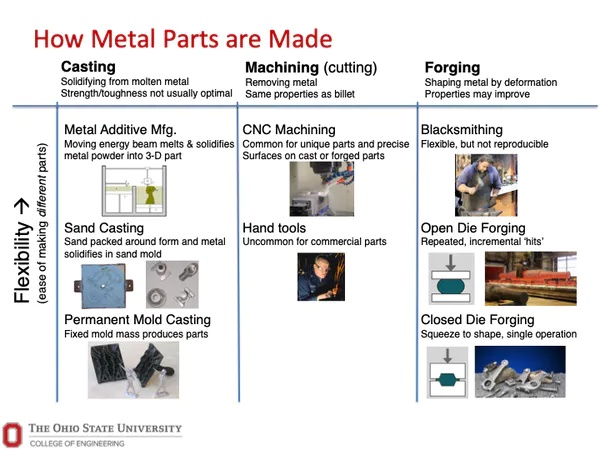Robotic Blacksmiths? Yeah!
When hammer and anvil meet bits. Possibly, everywhere.
As cool as it is, 3D printing unfairly gets too much coverage, compared to other technologies for digital manufacturing. One of them is Robotic Blacksmithing. Before explaining why, let me offer you a
Micro-vocabulary of metal manufacturing methods
Our civilization, if we can call it such, depends on metals, and has several ways to process them:

Caption: raditional metal manufacturing techniques. Glenn S. Daehn, CC BY
</em></u>
- Machining: cuts away raw material to get a desired shape
- Casting:* means pouring molten metal into a mold
- Forming, or forging: deforms and squeezes metal into new shapes
- Blacksmith: whoever “makes and repairs things in iron by hand”
Machining produces a lot of waste. 3D printing, or more professionally: addictive manufacturing because it adds material one little piece at a time instead of removing it, allows to create objects that would be impossible to make with machining. However, it is slow, and often cannot produce the “highest levels of strength or toughness” that are crucial in aeronautics and many other fields.
Enter blacksmithing

Why do metal artifacts, like the legendary Katana passed by Juan Ramirez to Connor Macleod, have super, seemingly immortal strength?
The reason is that “massaging” metals with iron and anvil makes their structure finer, more homogeneous: “as the material is shaped, it develops directional strength, much like wood is stronger along the direction of its grain."
The problem is that humans are good at forging small, unique objects like swords. Not great quantities of big objects, all exactly equal to each other. This is where robotic blacksmithing is useful.
A robot blacksmith is not a human-like machine holding a hammer in his “hands”. It is a press with movable, interchangeable parts, controlled by a computer, that form pieces of metal by pressing them in many consecutive, accurately controlled, endlessly reproducible steps.
In this way, it is possible to produce in series both small objects and the big “bones inside aircraft, ships, submarines and locomotives” of excellent quality, in ways not possible, or not cost-effective, with 3D printing.
I wrote “it is”, but in practice, still “much research and development remains before we [actually] have autonomous machines shaping metal into unique safety-critical items”.
The question is “where”?
The main theme of the article from which I took the previous quotes (go read it!) is that “robotic blacksmithing could revive US manufacturing”.
Allow me to ask: why only US manufacturing? Why not high-tech manufacturing wherever it is needed?
The world already has too many problems with economic instability, and embarrassingly meaningless trade. Robotic blacksmithing is a technology that, just like regional microprocessors, should be as distributes as possible, if the goal is to reduce both pollution and opportunities for conflicts.
Where do you plug a robotic blacksmith?
Another interesting side of robotic blacksmithing is its energy requirements. Making metal white hot, and beating it until it has just that exact shape is not stuff that you can power off a photovoltaic panel or two. This is something that, to be economically sustainable, may need lots of surely, immediately available energy. Clusters of local factories using robotic blacksmithing and similar technologies may be another political reason to have small nuclear reactors.
Who writes this, why, and how to help
I am Marco Fioretti, tech writer and aspiring polymath doing human-digital research and popularization.
I do it because YOUR civil rights and the quality of YOUR life depend every year more on how software is used AROUND you.
To this end, I have already shared more than a million words on this blog, without any paywall or user tracking, and am sharing the next million through a newsletter, also without any paywall.
The more direct support I get, the more I can continue to inform for free parents, teachers, decision makers, and everybody else who should know more stuff like this. You can support me with paid subscriptions to my newsletter, donations via PayPal (mfioretti@nexaima.net) or LiberaPay, or in any of the other ways listed here.THANKS for your support!